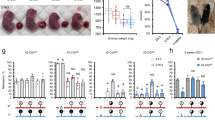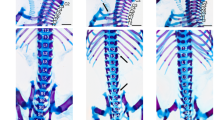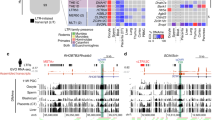Abstract
The Mas protooncogene on mouse chromosome 17 encodes a mitogenic G-protein-coupled cell surface receptor. We investigated the allele-specific expression pattern of the Mas gene on the basis of its proximity to the known imprinted gene for the insulin growth factor type II receptor (Igf2r). Phenotyping of mRNA demonstrated exclusive expression from the paternal allele in all embryonic tissues, including visceral yolk sac, between 11 and 12.5 days of gestation. By 13.5 days of gestation the paternal allele-specific expression of Mas was restricted to heart, tongue and visceral yolk sac, whereas all other tissues exhibited relaxation of the parental imprint. Our results demonstrate parental imprinting of Mas and suggest that the maternally inherited allele is transcriptionally repressed in a developmental and tissue-specific manner.
This is a preview of subscription content, access via your institution
Access options
Subscribe to this journal
Receive 12 print issues and online access
$209.00 per year
only $17.42 per issue
Buy this article
- Purchase on Springer Link
- Instant access to full article PDF
Prices may be subject to local taxes which are calculated during checkout
Similar content being viewed by others
References
Surani, M.A.H., Barton, S.C. & Norris, M.L. Nuclear transplantation in the mouse: Heritable differences between parental genomes after activation of the embryonic genome. Cell 45, 127–136 (1986).
Barton, S.C., Surani, M.A.H. & Norris, M.L. Role of paternal and maternal genomes in mouse development. Nature 311, 374–376 (1984).
McGrath, J. & Solter, D. Completion of mouse embryogenesis requires both the maternal and paternal genomes. Cell 37, 179–183 (1984).
Solter, D. Differential imprinting and expression of maternal and paternal genomes. A. rev. Genet. 22, 127–146 (1988).
DeChiara, T.M., Robertson, E.J. & Efstratiadis, A. Parental imprinting of the mouse insulin-like growth factor II gene. Cell 64, 849–859 (1991).
Bartolomei, M.S., Zemel, S. & Tilghman, S.M. Parental imprinting of the mouse H19 gene. Nature 351, 153–155 (1991).
Leff, S.E. et al. Maternal imprinting of the mouse Snrpn gene and conserved linkage homology with the human Prader-Willi syndrome region. Nature Genet. 2, 259–264 (1992).
Barlow, D.P., Stoger, R., Herrmann, B.G., Saito, K. & Schweifer, N. The mouse insulin-like growth factor type-2 receptor is imprinted and closely linked to the Tme locus. Nature 349, 84–87 (1991).
Cebra-Thomas, J.A. et al. Localization of the Mas proto-oncogene to a densely marked region of mouse chromosome 17 associated with genomic imprinting. Genomics 13, 444–446 (1992) (Erratum, Genomics 14, 208).
Birchmeier, C., Young, D. & Wigler, M. Characterization of two new human oncogenes. Cold Spring Harbor Symp. Quant. Biol. 51, 993–1000 (1986).
Young, D., Waitches, G., Birchmeier, C., Fasano, O. & Wigler, M. Isolation and characterization of a new cellular oncogene encoding a protein with multiple potential transmembrane domains. Cell 45, 711–719 (1986).
Jackson, T.R., Blair, L.A.C., Marshall, J., Goedert, M. & Hanley, M.R. The mas oncogene encodes an angiotensin receptor. Nature 335, 437–440 (1988).
Andrawis, N.S., Dzau, V.J. & Pratt, R.E. Autocrine stimulation of mas oncogene leads to altered growth control. Cell Biol. Int. Rep. 16, 547–556 (1992).
Villar, A.J. & Pedersen, R.A. Spatially restricted imprinting of mouse chromosome 7. Mol. Reprod. Dev. 37, 247–254 (1994).
Martin, K.A., Grant, S.G.N. & Hockfield, S. The mas proto-oncogene is developmentally regulated in the rat central nervous system. Dev. Brain Res. 68, 75–82 (1992).
Reik, W. Genomic imprinting and genetic disorders in man. Trends Genet. 5, 331–336 (1989).
Ogawa, O. et al. Relaxation of insulin-like growth factor II gene imprinting implicated in Wilms' tumour. Nature 362, 749–751 (1993).
Ohlsson, R. et al. IGF2 is parentally imprinted during human embryogenesis and in the Beckwith-Wiedemann syndrome. Nature Genet. 4, 94–97 (1993).
Rainier, S. et al. Relaxation of imprinted genes in human cancer. Nature 362, 747–749 (1993).
Giddings, S.J., King, C.D., Harman, K.W., Flood, J.F. & Carnaghi, L.R. Allele-specific inactivation of insulin 1 and 2, in the mouse yolk sac, indicates imprinting. Nature Genet. 6, 310–313 (1994).
Monnot, C. et al. Cloning and functional characterization of a novel mas-related gene, modulating intracellular angiotensin II actions. Molec. Endocrinol. 5, 1477–1487 (1991).
Hanley, M.R. Molecular and cell biology of angiotensin receptors. J. cardiovasc. Pharmacol. 18 (Suppl. 2), S7–S13 (1991).
Chaillet, J.R., Vogt, T.F., Beier, D.R. & Leder, P. Parental-specific methylation of an imprinted transgene is established during gametogenesis and progressively changes during embryogenesis. Cell 66, 77–83 (1991).
Brandeis, M. et al. The ontogeny of allele-specific methylation associated with imprinted genes in the mouse. EMBO J. 12, 3669–3677 (1993).
Li, E., Beard, C. & Jaenisch, R. Role for DNA methylation in genomic imprinting. Nature 366, 362–365 (1993).
Stoger, R. et al. Maternal-specific methylation of the imprinted mouse Igf2r locus identifies the expressed locus as carrying the imprinting signal. Cell 73, 61–71 (1993).
Zemel, S., Bartolomei, M.S. & Tilghman, S.M. Physical linkage of two mammalian imprinted genes, H19 and insulin-like growth factor 2. Nature Genet. 2, 61–65 (1992).
Re, R.N. Cellular mechanisms of growth in cardiovascular tissue. Am. J. Cardiol. 60, 1041–1091 (1987).
McClelland, M. & Nelson, M. Enhancement of the apparent cleavage specificities of restriction endonucleases: applications to megabase mapping of chromosomes. Gene Amplif. Anal. 5, 257–282 (1987).
Varmuza, S. & Mann, M. Genomic imprinting — defusing the ovarian time bomb. Trends Genet. 10, 118–123 (1994).
Moore, T. & Haig, D. Genomic imprinting in mammalian development. A parental tug-of-war. Trends Genet. 7, 45–49 (1991).
Gold, J.D. & Pedersen, R.A. Mechanisms of genomic imprinting in mammals. Current Topics in Dev. Biol. 29, 227–280 (1994).
Pedersen, R.A., Sturm, K.S., Rappolee, D.A. & Werb, Z. Effects of imprinting on early development of mouse embryos, in Preimplantation embryo development (ed. Bavister, B.D.) 212–226 (Springer-Veriag, New York, (1993).
Janssen, J.W.G., Steenvoorden, A.C.M., Schmidtberger, M. & Bartram, C.R. Activation of the mas oncogene during transfection of monoblastic cell line DNA. Leukemia 2, 318–320 (1988).
van't Veer, L.J., van den Berg-Bakker, L.A.M., Hermens, R.P.M.G., Deprez, R.L. & Schrier, P.I. High frequency of mas oncogene activation detected in the NIH3T3 tumorigenicity assay. Oncogene Res. 3, 247–254 (1988).
van't Veer, L.J. et al. Activation of the mas oncogene involves coupling to human alphoid sequences. Oncogene 8, 2673–2681 (1993).
Chirgwin, J.M., Przybyla, A.E., MacDonald, R.J. & Rutter, W.J. Isolation of biologically active ribonucleic acid from sources enriched in ribonuclease. Biochemistry 18, 5294–5299 (1979).
Rappolee, D.A., Brenner, C.A., Schultz, R., Mark, D. & Werb, Z. Developmental expression of PDGF, TGF-α, and TGF-β genes in preimplantation mouse embryos. Science 241, 1823–1825 (1988).
Rappolee, D.A., Mark, D., Banda, M.J. & Werb, Z. Wound macrophages express TGF-α and other growth factors in vivo: analysis by mRNA phenotyping. Science 241, 708–712 (1988).
Sanger, F., Nicklen, S. & Coulson, A.R. DNA sequencing with chain-terminating inhibitors. Proc. natn. Acad. Sci. U.S.A. 74, 5463–5467 (1977).
Fort, P. et al. Various rat adult tissues express only one major mRNA species from the glyceraldehyde-3-phosphate-dehydrogenase multigenic family. Nucl. Acids Res. 13, 1431–1442 (1985).
Author information
Authors and Affiliations
Rights and permissions
About this article
Cite this article
Villar, A., Pedersen, R. Parental imprinting of the Mas protooncogene in mouse. Nat Genet 8, 373–379 (1994). https://doi.org/10.1038/ng1294-373
Received:
Accepted:
Issue Date:
DOI: https://doi.org/10.1038/ng1294-373
This article is cited by
-
Expression of the Mas receptor is upregulated in skeletal muscle wasting
Histochemistry and Cell Biology (2015)
-
Post-natal imprinting: evidence from marsupials
Heredity (2014)
-
Devil and angel in the renin–angiotensin system: ACE–angiotensin II–AT1 receptor axis vs. ACE2–angiotensin-(1–7)–Mas receptor axis
Hypertension Research (2009)
-
The imprinted antisense RNA at the Igf2r locus overlaps but does not imprint Mas1
Nature Genetics (2000)
-
Imprinted expression of the Igf2r gene depends on an intronic CpG island
Nature (1997)



